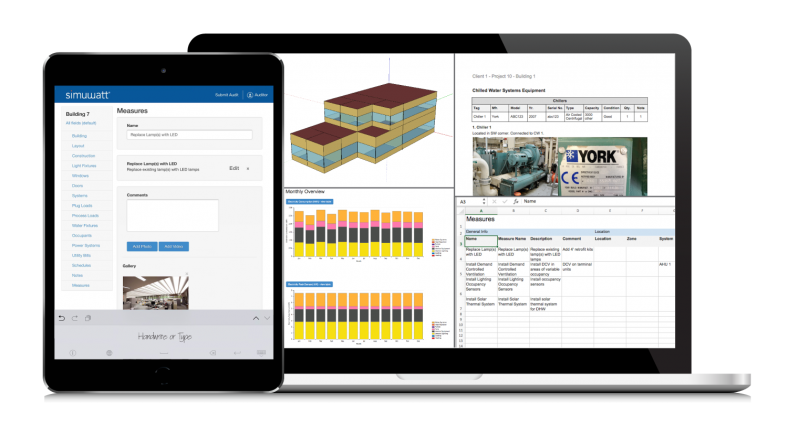simuwatt is excited and honored to appear on the DOE End-use Breakdown blog.

Amir Roth, Ph.D. - Building Energy Modeling Technology Manager, Building Technologies Office
Building energy auditing—the collection of energy-relevant building data and its organization into understandable and actionable form—is an important part of maintaining and improving building energy-efficiency. It is reinforced by a growing number of mandates including ones by the Department of Defense (DoD) and cities such as San Francisco and New York.
Auditing comes in several “levels.” For retrofits, an ASHRAE level II or “investment grade” audit requires on-site data collection about the building, its equipment, their present condition and current occupancy and use patterns. Back at the office, this information is combined with energy use data to create a calibrated energy model of the building, which serves as the basis for analyzing potential upgrades and investments. Currently, this process involves paper forms and manual model creation, calibration, and energy conservation measure (ECM) evaluation. However, several firms are streamlining and automating this process, simultaneously improving auditing output quality while reducing effort and cost.
One of these is Denver-based simuwatt®. In 2015, simuwatt (formerly Concept3D) completed a three-year project for the DoD Environmental Security Technology Certification Program (ESTCP) to prototype a mobile energy auditing application and to demonstrate its use in DoD bases. Since then, simuwatt spun off as a separate company and invested $1.5 million of private capital into the Energy Auditor product. Last month, relaunched Energy Auditor’s energy modeling module commercially.
The simuwatt platform leverages the cloud to facilitate both collaboration and analysis. The Energy Auditor tablet application guides the auditor through field data collection and ECM identification. In the cloud, simuwatt uses the data to automatically generate an energy model, which can be calibrated using measured energy use data, and which serves as the basis for retrofit analysis. simuwatt automatically generates reports in Microsoft Word and Excel formats. Overall, simuwatt reduces field auditing and energy modeling costs by over 25% each.
simuwatt’s energy modeling capabilities are built on OpenStudio™, DOE’s open-source application development platform for EnergyPlus™, its open-source energy modeling engine. simuwatt leverages the OpenStudio application programming interface (API) to quickly create models from data. OpenStudio Measures—scripts that transform models—are used to explore ECM packages.
The National Renewable Energy Laboratory’s (NREL’s) OpenStudio team provided technical and integration support on the project. “The simuwatt team has been working with NREL over the past several years on everything from product prototyping to commercialization,” says Oliver Davis, simuwatt CEO and founder. “In addition to delivering the most powerful and widely accepted energy modeling platform, they have made it really easy to use. Even with a $70+ billion dollar worldwide retrofit market, too many energy audits sit on the shelf. simuwatt aims to remove barriers by simplifying building energy information collection and providing output that is actionable and bankable. We want to allow anyone to identify and act on energy efficiency. DOE’s energy modeling tools are helping simuwatt realize this opportunity. We see benefit in other DOE tools such as BuildingSync and SEED for large data integration projects.”
simuwatt is one of 10 startups recently accepted into the third round of the Wells Fargo Innovation Incubator (IN2) program. Launched in 2014, IN2 is funded by the Wells Fargo Foundation and co-administered by NREL. The initiative fosters and accelerates early-stage commercial building technologies. As part of the program, the simuwatt and NREL teams will work together to accelerate its product development for broader market use at the building owner level.
Source: https://energy.gov/eere/buildings/articles/simuwatt-relaunches-energy-auditor
